“Beauty is in the eye of the beholder.” So said Margaret Wolfe Hungerford in Molly Bawn (1878). Her sentiment applies quite well to one of my favorite walks, out of the many on Cape Cod.
This one is easy to reach from either end, borderline accessible, and close to my home. But few people would single it out as an outstanding nature walk.
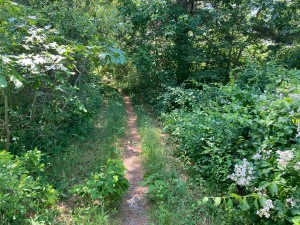
Snake Creek Road
The walk is along Snake Creek Road, aka Way 672, in Wellfleet. The road was once passable by large vehicles, but due to downed trees, not any more. It’s best suited to walkers, brave runners, and the occasional horse rider.
The road is maintained simply by its use. There are no trail markers, maps, or guide booklets. Some parts are wide and clear; others remind the visitor to wear protection against twisted branches and roots, prickly thorns, and poison ivy. Conditions change with the weather and as tree branches fall across the path.

Unlike many trails I’ve enjoyed, Snake Creek Road is not an official National Seashore trail. Nor is it a trail of the Wellfleet Conservation Trust, Massachusetts Audubon, or some other such organization. There’s a road sign, but nothing to indicate that you can, with a little difficulty, walk the 3/4 miles, but not drive it.
There are about ten houses on a bluff above the road. You might be able to hear people on a deck talking, but usually they aren’t close enough for you to hear what they’re saying. Similarly, you’ll be far enough away that they probably won’t see or hear you.
Flora
Snake Creek Road is a great place to explore the question:
Which invasive plant would win if we put them all together in one place?

Here you’ll find bramble, poison ivy, Virginia creeper, autumn olive, both bush and vine honeysuckle, phragmites, broadleaf dock, buckthorn, garlic mustard, oriental bittersweet, black locust, Japanese knotweed, bamboo, and much more. There are also magnificent spreads of multiflora rose blooming in various colors.
In one section there’s a large stand of lily of the valley, both alongside the trail and on the walkway itself. Like many of its partners in the ecosystem, it’s invasive, toxic, medicinal, good for wildlife, and beautiful.
We’re taught to resist invasives and to stamp them out at all costs. Given the choice, I’d prefer a healthy native plant ecosystem. But I can’t help but be in awe of the signs of life bursting through, without the need of harmful fertilizer, herbicides, or constant tending.
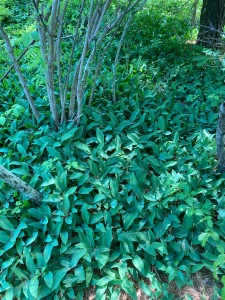
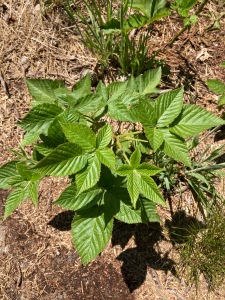
Besides, there are also many native plants along Snake Creek, including moss, bayberry, bearberry, beach plum, mayapple, reed grass, black cherry, bear oak, fir, pitch pine, and white pine, to name just a few. There are introduced plants, such as Norway spruce as well.
Best of all, it’s easy to find many prime examples of lichen, including green shield, fishnet, and reindeer lichen. They steadfastly refuse to be placed in a simple category like “flora” or “fauna,” preferring “mycota.” They’re accompanied by wood ears and the underground fungi with their occasional spore-bearing fruiting bodies.

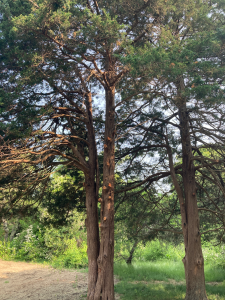
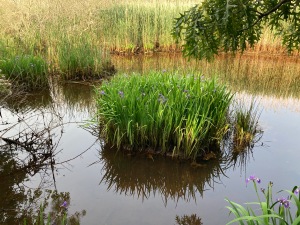
Fauna
Snake Creek is home to all sorts of animals as well––birds, reptiles, mammals, and countless invertebrates. The creek (aka Herring River), despite its degradation from being dammed, is home to various fish, such a the eponymous herring, frogs, turtles, and even river otters.

On the land side there are coyotes, rabbits, fox, snakes, squirrels, chipmunks, mice, and voles. In addition to many songbirds, I’ve seen swans and great blue herons close up, ospreys and hawks overhead. And many crows. Woodpeckers enjoy the many damaged trees.
When I walk leisurely, I feel that I’m inside a marvelous habitat space like those in some modern zoos. But this is one that’s self-maintaining and ever-changing.
A couple of days ago, as the weather had warmed a little, I almost stepped on a 4-5 foot black racer sunning itself on the trail.
I’ve been especially intrigued to follow the evolution of two dens along the trail. I believe they’re made by coyotes, which I’ve heard at night, but they could be for foxes. Recently they’ve deteriorated without repair, suggesting that the canine families have moved on.


This beholder
I can’t say that Snake Creek is the best 3/4 mile walk anywhere. It’s rather flat and straight, and there are too many signs of degradation from human activity. It will also be changing in a major way soon, with the restoration of the Herring River tidal flow. I expect it to be inundated at high tide after that. It will be a salt marsh habitat and more of a mud flat or at low tide.

Moreover, the possibility of getting lost is one of my top criteria for a good walk, and that’s very hard to do on a straight line path with a bluff on one side and a river on the other.
But a walk from one end to the other and back has never failed to yield surprises and contentment that can be found in few other ways.
